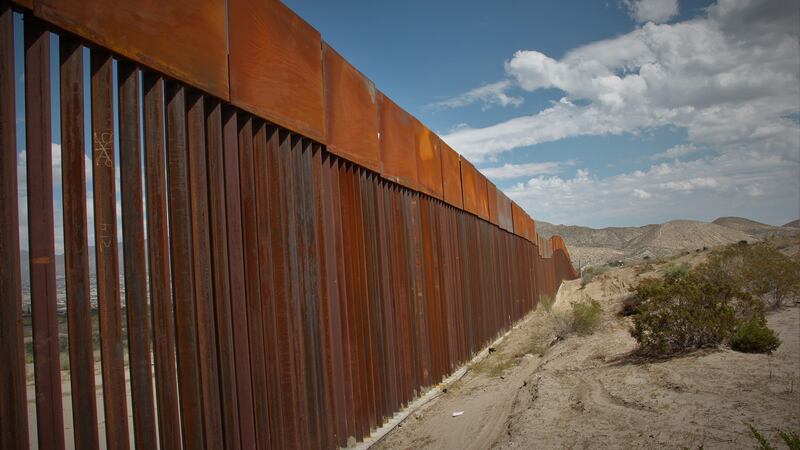José Alfredo stares northwards across a broad valley, over the border that separates the dirt-poor suburb of Puerto de Anapra in Mexico from Sunland Park in the state of New Mexico. He points in the direction of a group of white buildings far in the distance. "You see those? That's where my mother and sister live," he says. "Though if something happens to my mother, I won't be able to go see her."
Alfredo used to live in the US, too. His family left Mexico when he was nine, one of millions of undocumented migrants hoping to make a new life there, and moved to Echo Park in Los Angeles. Alfredo says he later lived in various parts of America, but in November 1999 was deported back to Mexico after a drugs possession charge.
Puerto de Anapra is 10km northwest of the Mexican border city of Ciudad Juárez, and for years has been a conduit for illegal migrants attempting to slip into the US. A steep hill on the Mexican side of the border and a simple chain-link fence, easily breached using a bolt-cutters, made for a straightforward covert entry.
Last summer, however, a 6m-high fence, complete with a deep concrete foundation and topped with flat, thick sheets of metal running for 2½km, was completed along this stretch of the frontier. Though it's a formidable barrier, it's not enough for US president Donald Trump, who wants a wall built along the entire length of the US-Mexico border.
Scaling the fence
Nevertheless, in Puerto de Anapra, the migrants still come. A man wearing a high-vis jacket working close to the fence says he still sees a lot of migrants coming here and scaling the fence at night. “I see about 40-50 people a week,” says another man, standing up from washing an SUV in the scorching desert sun in the town centre. “Most of them are Mexicans.”
It hasn’t taken long for protest graffiti to make its mark on the imposing new fence. “Not delinquents nor illegals are we. We are international workers,” one slogan painted in Spanish declares. To its right, a smaller, though no less angry message written in English and Spanish proclaims: “F*** Trump and his f***ing wall.”
Trump's proposed "big, beautiful wall" aimed at stopping illegal immigrants, drug smuggling and people-trafficking into the US, was a signature election campaign promise. As a presidential candidate, he said the wall could be built for $4 billion, and now, as president, he continues to insist that Mexico will pay for it. Four companies were shortlisted in August by the US Customs and Border Protection agency to build eight wall prototypes that are being tested in southern California this autumn.
I think Trump is right to stop people from illegally entering the US. It's the responsibility of the Mexican government to provide its own people with jobs, it's not Trump's
But Trump’s plans have hit road bumps. Senate Democrats say the wall could cost as much as $67 billion, while Mexico has made its position clear through a statement by its foreign ministry that “our country will not pay, under any circumstances, for a wall or physical barrier built on US territory along the Mexican border”.
Opposition
In Ciudad Juárez, there is, unsurprisingly, plenty of opposition to the plan.
"I don't think Mexico can be made to or should pay for a new wall," says Araceli, a woman who runs a hotel close to the number 51 border bridge to El Paso, and who asked not to be fully identified. "We and the workers who go over there leave a lot of money in the US. If Trump wants a wall, he has to pay for it."

Others disagree.
“I think Trump is right to stop people from illegally entering the US. It’s the responsibility of the Mexican government to provide its own people with jobs, with a good life, it’s not Trump’s,” says José Alfredo, who now works as an Uber driver. “And stopping illegals is the law.”
In the centre of Ciudad Juárez, the divisions between Mexico and its wealthier neighbour to the north are easily viewed standing on the Avenue Benito Juárez. Here, a steady line of huge SUVs with Texan and other US registration plates speed northwards over the Santa Fe bridge into El Paso. Their windows are rolled up, separating those inside from the world outside and the oppressive heat.
Positive changes
There is an argument that a new border wall may lead to positive changes in Ciudad Juárez because a secure border may mean drug traffickers – and the crime and violence that follow them – would be forced away from the city, to rural areas where it is easier to breach the border.
But Araceli, the hotelier, is not convinced by that. “Even if a wall is built here, I don’t think it would solve anything, it wouldn’t stop the drug smuggling and the gang activity. They’ll find a way to get it through,” she says.
For José Alfredo, who says he shares many of Trump’s views, the scrapping on September 5th of the Deferred Action for Childhood Arrivals programme, which protected illegal immigrants’ children from deportation, was a step too far.
“I think their situation is very different from the people trying to get in illegally under a border fence. There should be some compassion for kids who were brought to the States by their parents when they were four or five years old,” he says as we drive along the highway that splits downtown El Paso from Ciudad Juárez. “It’s not their fault.”










